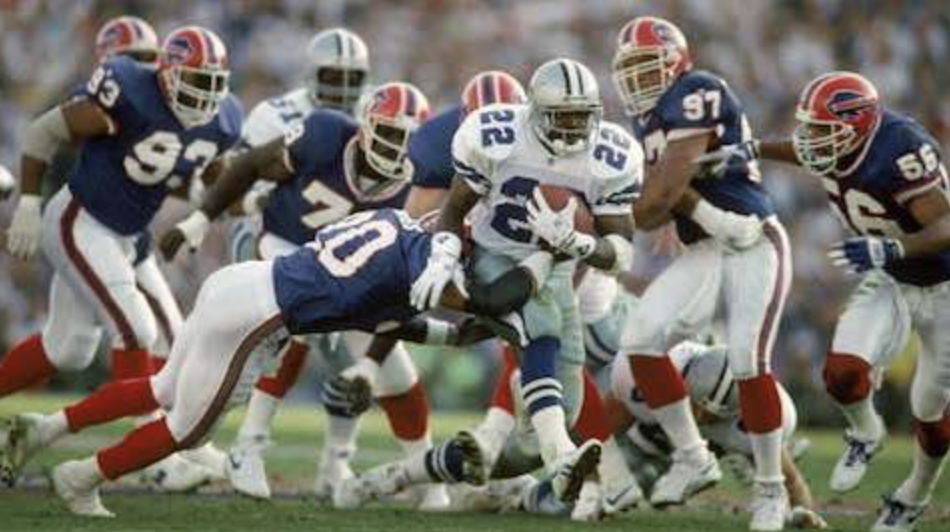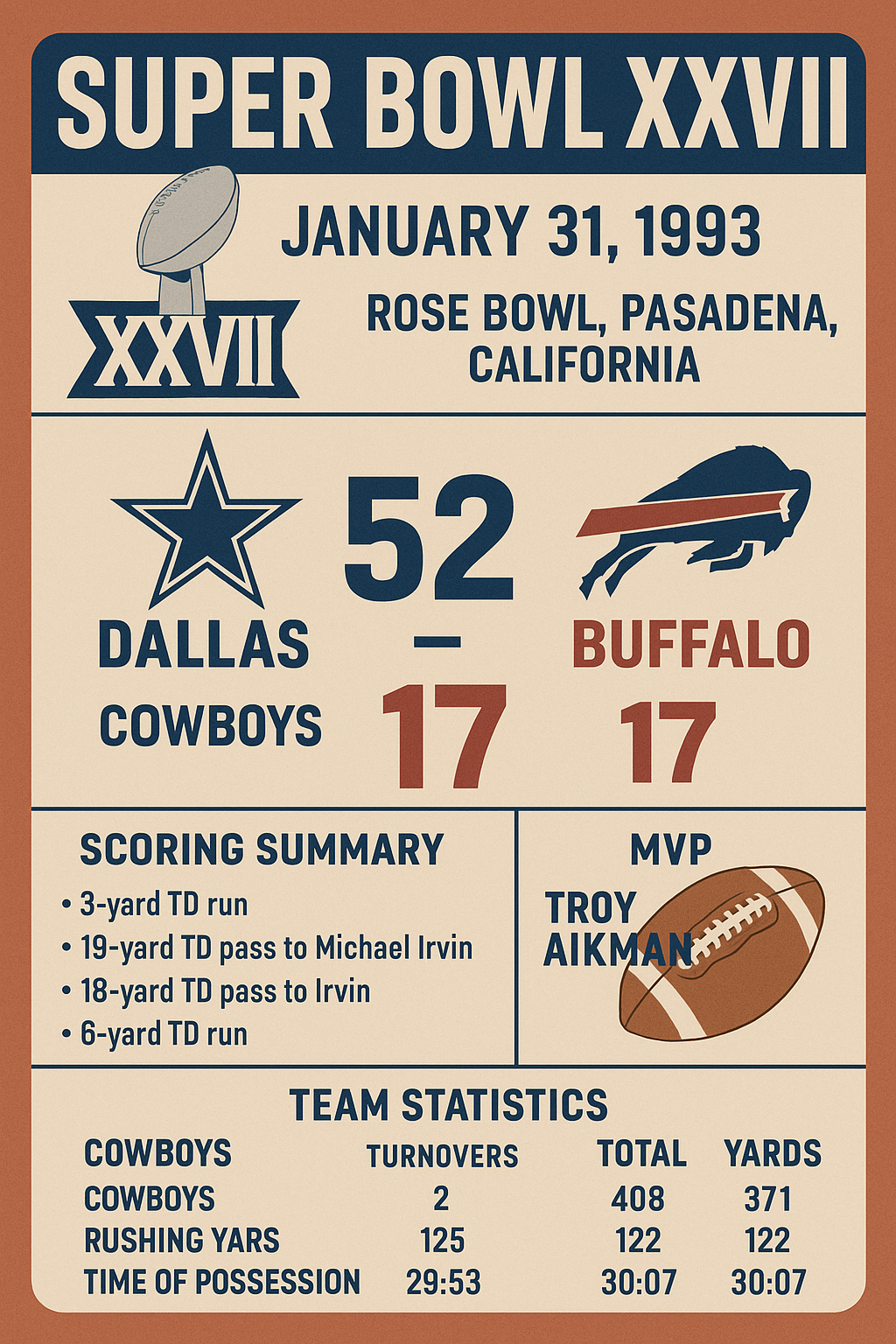Super Bowl XXVII: The Birth of a 90s Dynasty

On January 31, 1993, in the balmy city of Pasadena, California, at the famed Rose Bowl, the Dallas Cowboys delivered a performance so dominant that it echoed through the annals of NFL history. In Super Bowl XXVII, Dallas demolished the Buffalo Bills 52–17, signaling not just the return of America’s Team but the beginning of a new dynasty.
This game wasn’t just a contest—it was a coronation. With a roster brimming with young talent and Hall of Fame potential, the Cowboys kicked off the 1990s in style, while the Bills suffered yet another crushing defeat, their third consecutive Super Bowl loss.
“Super Bowl XXVII was a seismic shift,” says Leroy Chamberlain, senior historian at the Super Bowl Historical Society. “It was the day Dallas stopped being a rebuilding team and officially became a juggernaut.”
Background: Two Teams, Two Different Directions
Heading into the big game, the Buffalo Bills were seasoned postseason veterans. Under head coach Marv Levy, they were making their third consecutive Super Bowl appearance. Their high-powered “K-Gun” offense, featuring quarterback Jim Kelly, running back Thurman Thomas, and wide receiver Andre Reed, had overwhelmed the AFC once again. But despite their talent, they hadn’t yet translated regular season success into Super Bowl glory.
The Cowboys, in contrast, were on the rise. Under head coach Jimmy Johnson, Dallas had gone from a 1–15 disaster in 1989 to NFC champions in just four years. Fueled by the “Triplets”—quarterback Troy Aikman, running back Emmitt Smith, and wide receiver Michael Irvin—Dallas finished the regular season 13–3. Their roster was a blend of young stars and fearsome defenders like Charles Haley and Leon Lett, all orchestrated by Johnson’s fiery leadership.
This was more than a game; it was a clash of eras.
The Game: A Turnover Avalanche
The Rose Bowl buzzed with anticipation as the two teams took the field. But it didn’t take long for Dallas to assert control. From the very first possession, the Cowboys’ defense suffocated Buffalo’s offense, forcing a fumble that led to an early touchdown.
The game turned into a turnover nightmare for the Bills. Buffalo committed a staggering nine turnovers—a Super Bowl record—including four lost fumbles and five interceptions. Every time the Bills seemed to get a drive going, they coughed up the ball.
Meanwhile, Troy Aikman played one of the most efficient Super Bowl games of all time. He completed 22 of 30 passes for 273 yards and four touchdowns, earning Super Bowl MVP honors. His chemistry with Irvin was unstoppable, particularly in the second quarter when Dallas blew the game open.
By halftime, the Cowboys led 28–10, and the game was effectively over.
Troy Aikman’s Masterclass
It’s hard to overstate just how precise and confident Aikman looked. His timing was perfect, his deep balls were flawless, and he delivered under pressure.
“Aikman didn’t just win a Super Bowl—he put on a clinic,” said Eleanor McKnight, curator at the Super Bowl Historical Society. “He played with the poise of a 10-year veteran, not someone in his first title game.”
He found Michael Irvin for two second-quarter touchdowns just 18 seconds apart—a Super Bowl record—and exploited mismatches all over the field. The offensive line, led by Nate Newton and Mark Tuinei, kept the Bills’ defensive front in check, giving Aikman all the time he needed.
The Buffalo Collapse
For Buffalo, it was the same song with a worse verse. Jim Kelly exited the game early in the second quarter with a knee injury after a hard hit. Frank Reich, his backup (and the orchestrator of the greatest playoff comeback in NFL history just weeks earlier), tried to keep the offense alive, but it was too little too late.
Thurman Thomas, the reigning league MVP just a season prior, was held to 19 rushing yards on 10 carries and fumbled three times. Andre Reed had six receptions but was mostly limited to short gains.
Buffalo’s unraveling reached a low point in the fourth quarter when Leon Lett, after recovering a fumble and sprinting toward the end zone for a sure touchdown, held the ball out in celebration—only to have Don Beebe chase him down and knock it out at the 1-yard line.
The play didn’t change the outcome, but it became one of the game’s most iconic moments—a symbol of hustle amid humiliation.
Key Statistics
| Team | Dallas Cowboys | Buffalo Bills |
|---|---|---|
| Points | 52 | 17 |
| Turnovers | 2 | 9 |
| Total Yards | 408 | 371 |
| First Downs | 22 | 25 |
| Time of Possession | 29:53 | 30:07 |
| Rushing Yards | 125 | 122 |
Despite a relatively close yardage count, the turnover disparity completely tilted the game in Dallas’ favor.
Final Score
Dallas Cowboys: 52
Buffalo Bills: 17
The 52 points scored by Dallas were the second-most in Super Bowl history at the time (behind San Francisco’s 55 in Super Bowl XXIV), and their 35-point margin of victory tied for the third-largest.

Legacy of Super Bowl XXVII
This game marked the start of a Dallas dynasty. The Cowboys would go on to win three Super Bowls in four years (XXVII, XXVIII, and XXX), becoming the team of the 1990s. The victory validated Jimmy Johnson’s vision and Jerry Jones’ aggressive management style.
For Troy Aikman, Michael Irvin, and Emmitt Smith, it was just the beginning. All three would be enshrined in Canton by the decade’s end, their legacy sealed in part by what happened in Pasadena.
Buffalo, meanwhile, had to confront a painful reality. They were now 0–3 in Super Bowls, with one more heartbreak still to come.
Cultural Significance
Super Bowl XXVII was more than just a game; it was a media spectacle. Michael Jackson headlined the halftime show, delivering a game-changing performance that set a new standard for Super Bowl entertainment.
The game was broadcast on NBC, drawing over 90 million viewers. Commentary by Dick Enberg and Bob Trumpy framed the contest as a classic offense vs. defense battle—but by halftime, the narrative had already been rewritten: the Cowboys were simply too much.
Players Who Defined the Game
- Troy Aikman: 273 yards, 4 TDs, Super Bowl MVP
- Michael Irvin: 6 receptions, 114 yards, 2 TDs
- Emmitt Smith: 108 total yards, 1 TD
- Charles Haley: constant pressure on both QBs
- James Washington: 2 turnovers forced on defense
- Leon Lett: unforgettable (and teachable) moment at the goal line
For Buffalo:
- Jim Kelly: Injured early, 82 yards, 2 INTs
- Frank Reich: 194 passing yards, 2 TDs, 2 INTs
- Thurman Thomas: 19 rushing yards, 3 fumbles
Coaching Spotlight: Jimmy Johnson
Johnson’s aggressive, fast-paced defense combined with a disciplined offensive attack created the perfect storm. His work in rebuilding the Cowboys from 1–15 to Super Bowl champions in just four years is one of the greatest turnarounds in sports history.
He made gutsy personnel moves, traded Herschel Walker for draft capital, and trusted youth in a league built on veterans.
Johnson’s fiery demeanor and college-style motivation brought out the best in his players. His postgame quote—“How ’bout them Cowboys!”—became a catchphrase for a generation.
Buffalo's Response: Perseverance Amid Pain
While the defeat was humiliating, the Bills once again responded with resilience. They would return to the Super Bowl in 1994 for a fourth consecutive appearance—a feat no other NFL team has ever matched.
But Super Bowl XXVII became symbolic of Buffalo’s fatal flaw: an inability to protect the football in the biggest moments.
Closing Thoughts
Super Bowl XXVII was a turning point—not just for the Cowboys or the Bills, but for the NFL itself. It introduced a new wave of dominance, ushered in a new generation of superstars, and delivered one of the most lopsided beatdowns in Super Bowl history.
“In terms of raw execution and complete team performance,” said Chamberlain, “Super Bowl XXVII might be the most definitive blowout since the 49ers crushed the Broncos in XXIV. The Cowboys announced they were here to stay—and they weren’t kidding.”
Indeed, they weren’t. The 90s belonged to Dallas. Super Bowl XXVII was the start of it all.